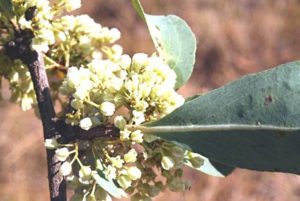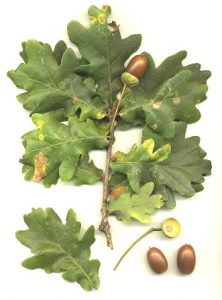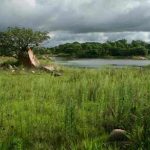TREE LIFE
September 2010
MASHONALAND CALENDAR
Please note that there will be no 3rd Sunday outing this month as the Society will be away at Aberfoyle.
Saturday, 25th September: Domboshawa. An afternoon visit to one of our regular haunts. We will meet at 2.30 p.m. There will be an entry fee, so please bring some money.
Directions: Take the Borrowdale Road out of Harare and continue for ±33 km into the Chinhamora Communal Land. Turn right at the Domboshawa Cave sign and continue to the car park.
GOSHO PARK, NEAR MARONDERA – 15 AUGUST 2010
Eleven members of the Society made the trip out to Gosho Park on a sunny, cool, but pleasant day in August.
The history of Gosho is that in 1984 Peter Ginn, the well-known bird photographer and geography teacher at Peterhouse, approached the United Bottling Company, Mr Daryl Mitchell from Rakodzi farm and several others, and a fence was erected. Later, a pond was built and some game was introduced. The area is currently used by the Peterhouse group of schools for conservation purposes. It was named after Mr. Patrick Gosho, a former Estate Manager at Springvale House.
The vegetation is primarily miombo woodland, msasa and mnondo being major components. Many areas have a rocky flora and Brachystegia tamarindoides occurs from time to time.
The altitude where we started walking was 1,640 m (5,380 ft) and by the end of our morning walk was 1,670 m (5,480 ft), i.e. quite a high altitude. Rainfall is high and there are frequent mists, which provide some moisture during the dry season. Most trees are festooned with lichens. In addition to the woodland, there are also areas of vlei and grassland.
The last time that the Tree Society visited Gosho was 17 September 2000, nearly 10 years ago.
We were one month earlier than in 2000, and as we have noted around Harare the distinctively coloured leaves of the msasas seem to be quite late this year. On the many Tree Society trips which we did over the Heroes’ weekend (c. 11th and 12th August), we often saw splendid trees in full leaf. However, not this year. We did see one tree by the road between Harare and Marondera, but at Gosho Park all the msasas still had their old leaves.
We parked in the same spot as in 2000 and walked out into an open grassy area. There we found a small and, in my experience, unusual species of Euphorbia in flower. It is a small perennial with linear, almost ericoid, leaves named Euphorbia cyparissioides. Examination of the 2000 records shows that we found it in exactly the same spot 10 years earlier.
Basically it was too early in the year for the spring flowers, but we did surprisingly well as most trees still retained their leaves and we were able to name most of the trees we saw.
One of the few species in new, very green leaf and flower was (Rhus) Searsia longipes, which seemed to be very common in the understorey.
Also very common was the Bladder-nut, Diospyros whyteana. This high-rainfall species does not generally occur close to Harare (although we have one record of it from near Makumbi Mission in the Chinhamora Communal Land); you have to go eastwards along the watershed before it appears. I was surprised how common it was in the understorey and how shiny the leaves were. The name refers to the calyx, which is accrescent, that is it enlarges in fruit to form a bladder-like structure enclosing the seed. After a time, we came across some bushes with the remains of the red bladders, but all the bladders had been opened and the seed removed.
Also just coming into flower was Eriosema ellipticum. This is a true shrub, not a suffrutex as was the Eriosema englerianum we had seen in grassland earlier. It is a yellow-flowered legume with simple leaves and again tends to be a sign of higher rainfall areas – although this one is quite common around Harare – e.g. at Cleveland Dam.

Gymnosporia senegalensis (Confetti tree).
We stopped and looked at a specimen of Gymnosporia senegalensis (Confetti tree). This still bore some white flowers, but it is quite late in the year for this winter-flowering species. Typical were the greyish obovate leaves with red petioles.
Everywhere in rocky places ,and even in places which did not look particularly rocky, was Maytenus undata (Koko tree). We were able to fold the leaves and see the typical greyish line appear and also to smell the distinctive kitchen-cupboard-plastic odour.
At this point, we approached the base of a granite kopje with large piled up boulders. At the base was another special plant which we often see in the Marondera area, namely Apodytes dimidiata, the White pear. This has shiny simple alternate leaves and can be very puzzling if no flowers or fruits are present to give one a clue – as was the case here. This is another species which prefers high rainfall areas.
Some of us climbed the rocky hill. It was very grassy, and it appeared that fire had managed to get into it, limiting the extent of the woody vegetation. Here was Olinia vanguerioides (Zimbabwe hard-pear), a shrub or small tree with opposite rather Rubiaceae-like leaves as the specific name (Vangueria-like) suggests. Also present amongst the rocks was Ficus natalensis subsp. graniticola, with its relatively small obovate dark green leaves which are often truncate at the apex. A small tree was found covered in fruits.
Another species among the rocks was Sericanthe andongensis (Venda coffee). A little bit later in the year, this will be producing its distinctive white flowers, which we saw last year in November when we visited Ruzawi. However, at this stage there were leaves and flower buds only. It is another Rubiaceae with opposite leaves and interpetiolar stipules.
A very common tree which we saw in many places was Cussonia natalensis (the Simple-leaved cabbage-tree). Generally, it preferred rocky areas. The leaves go a bright yellow in winter, but most of the trees here had shed these leaves, and the spike-like inflorescences were just coming into flower.
We have puzzled before over the habitat requirements of this species. It is certainly a species of high altitude and high rainfall as its presence here and along the main road from about Bromley eastwards suggests. However, it also occurs in much drier locations at much lower altitudes as well.
Later we saw a single Cussonia spicata in the miombo woodland. This species at least is fairly clear in its high altitude and high rainfall requirements. We did not see the third Zimbabwean Cussonia, namely C. arborea, but I understand that it does also occur at Gosho.
After a time, we arrived at another camp with ablution facilities, and next to it was an extraordinary towering rock. I thought it might be used for abseiling but I could see no way, without some extraordinary mountaineering skills, that anyone could actually climb to the top.
On our way back for lunch, we came across a colony of (Rhus) Searsia kirkii plants in fruit. This is a suffrutex Searsia which never becomes a tree. The fruits were a reddish-orange colour and quite distinctive. Several photographers immediately clustered round it.
After lunch we did a walk going down the stream system, which contains three small dams. In this part of the woodland there was little or no Diospyros whyteana, but the msasa trees were well laden with epiphytic orchids. A fairly tame herd of impala was seen.
Nothing much new was added, but we did come across a colony of small Myrsine africana plants, a species which was new to some of the group. Examination under a lens showed the translucent orange-brown glands in the lamina of the leaf.
This was a very interesting and enjoyable day of botanising in very pleasant company. A return to this venue in the rainy season, I suspect, would provide some interesting herbaceous plants.
-Mark Hyde
Tree Lore—The Oak
Can any other plant or tree have so many myths and legends surrounding it? Not to mention the very real part that this tree had to play in England’s role in world history. For hundreds of years, oaks provided the building material for her naval warships, the source of England’s ‘Heart of Oak’.

Foliage and acorns of Quercus robur
Here are a few of the less weird ones.
• Because of its deep roots the oak symbolizes a god whose law extends to heaven, earth, and the underworld.
• The oak is said to be sacred to: Allah. Jehovah, Zeus, Jupiter, Thor, Mars, the Dagda, Hercules, Hou—the oak god of Guernsey, Janicot—the Basque oak god, El—the Middle Eastern oak god, Jove, Picus, Cernunnos, Herne—the Hunter, Taranis, Teutates, Belenos, Donar / Dunar / Thunar, Perkunas, Perun, Taraa, Baldur, Viribius, and Janus. It is also the tree of the wild ox-god.
• The image of Jupiter at the Capitol in Rome was originally an oak tree.
• Mary was worshiped as Our Lady of the Oak in Anjou, France. She appeared to shepherd children in Portugal as Our Lady of Fatima, crowned in roses and hovering over an oak tree.
• The oak is sacred to all thunder and lightning gods. Hercules attracted thunderstorms with sympathetic magic, by rattling an oak club in a hollow oak, or by stirring a pool with an oak branch. Clubs were made of oak in ancient Europe. Woodpeckers were thought to be knocking for rain when they tapped on oak trunks. Black animals were sacrificed to the thunder god for rain. Oaks were believed to court the lightning flash. An old English saying:
Beware of an oak
It draws the stroke.
• Rome awarded oak leaves to military heroes.
In Europe
• Primitive Europeans believed that oak fire strengthened the sun. Sacrifices were made to sacred oaks in Europe until well into the Middle Ages.
• It was a crime to fell an oak tree in pagan Ireland. Kildare, where the nuns of St. Brigit maintained the sacred fire, means Shrine of the Oak.
• In British folklore, ancient hollow trees (called bull oaks in England, bell oaks in Scotland and Ireland) are trees that stood in old sacred groves. They were often believed to be the home of spirits, elves, fairies or demons. You were supposed to turn your coat or cloak inside out to neutralize their magic:
Turn your cloaks
For fairy folks are in old oaks.
• Their spirits were believed to enter houses through the knotholes in oak timbers.
• Druids stood their sacred circles of stones under the shadow of a spreading oak or in a grove of oak trees. Pliny says that the Druids believed that anything found growing on an oak tree had been sent from heaven, a sign that the god had chosen the tree and made it sacred. Mistletoe found on oaks was held especially sacred. The Druids cut it each year with a golden sickle in a ritual emasculation of the sacred oak, the royal sun disc. Mistletoe does not usually grow on oaks, so it is likely that they grafted it. They associated the oak with heavenly fire. An oak tree had to be more than 30 years old before Druids would harvest mistletoe from it.
• Lithuanians offered sacrifices to oak trees for plentiful crops.
• Oak trees in Siberian groves were swathed in cloth and made offerings of kettles, reindeer hides, spoons and other valuable household articles. Orthodox Christians in Russia worshiped a holy oak until the 1870s. They fixed candles to its trunk and branches and prayed: ‘Holy oak, hallelujah, pray for us’.
Acorns
• Acorns were the Celtic symbol for Zeus, the Roman symbol of Jupiter. To Greeks and Romans, the cupped acorn represented the penis glans.
Magic
• Toothaches were cured in the 18th century by driving a nail into the tooth or gum until it bled, then driving the nail into an oak tree.



